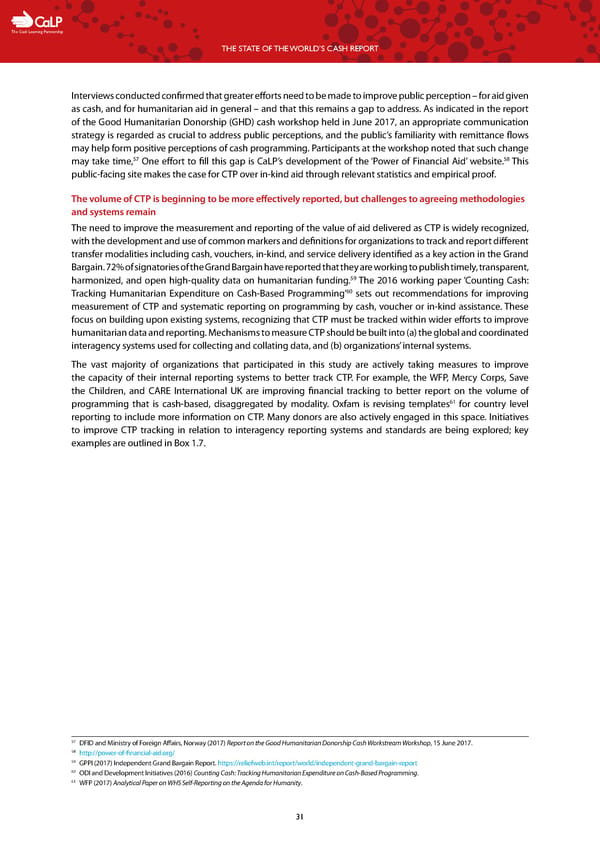C The Cash Learning Partnership THE STATE OF THE WORLD’S CASH REPORT Interviews conducted confirmed that greater efforts need to be made to improve public perception – for aid given as cash, and for humanitarian aid in general – and that this remains a gap to address. As indicated in the report of the Good Humanitarian Donorship (GHD) cash workshop held in June 2017, an appropriate communication strategy is regarded as crucial to address public perceptions, and the public’s familiarity with remittance flows may help form positive perceptions of cash programming. Participants at the workshop noted that such change 57 58 may take time, One effort to fill this gap is CaLP’s development of the ‘Power of Financial Aid’ website. This public-facing site makes the case for CTP over in-kind aid through relevant statistics and empirical proof. The volume of CTP is beginning to be more effectively reported, but challenges to agreeing methodologies and systems remain The need to improve the measurement and reporting of the value of aid delivered as CTP is widely recognized, with the development and use of common markers and definitions for organizations to track and report different transfer modalities including cash, vouchers, in-kind, and service delivery identified as a key action in the Grand Bargain. 72% of signatories of the Grand Bargain have reported that they are working to publish timely, transparent, 59 harmonized, and open high-quality data on humanitarian funding. The 2016 working paper ‘Counting Cash: 60 Tracking Humanitarian Expenditure on Cash-Based Programming’ sets out recommendations for improving measurement of CTP and systematic reporting on programming by cash, voucher or in-kind assistance. These focus on building upon existing systems, recognizing that CTP must be tracked within wider efforts to improve humanitarian data and reporting. Mechanisms to measure CTP should be built into (a) the global and coordinated interagency systems used for collecting and collating data, and (b) organizations’ internal systems. The vast majority of organizations that participated in this study are actively taking measures to improve the capacity of their internal reporting systems to better track CTP. For example, the WFP, Mercy Corps, Save the Children, and CARE International UK are improving financial tracking to better report on the volume of 61 for country level programming that is cash-based, disaggregated by modality. Oxfam is revising templates reporting to include more information on CTP. Many donors are also actively engaged in this space. Initiatives to improve CTP tracking in relation to interagency reporting systems and standards are being explored; key examples are outlined in Box 1.7. 57 DFID and Ministry of Foreign Affairs, Norway (2017) Report on the Good Humanitarian Donorship Cash Workstream Workshop, 15 June 2017. 58 http://power-of-financial-aid.org/ 59 GPPI (2017) Independent Grand Bargain Report. https://reliefweb.int/report/world/independent-grand-bargain-report 60 ODI and Development Initiatives (2016) Counting Cash: Tracking Humanitarian Expenditure on Cash-Based Programming. 61 WFP (2017) Analytical Paper on WHS Self-Reporting on the Agenda for Humanity. 31
 The State of the World's Cash | Full Report Page 32 Page 34
The State of the World's Cash | Full Report Page 32 Page 34